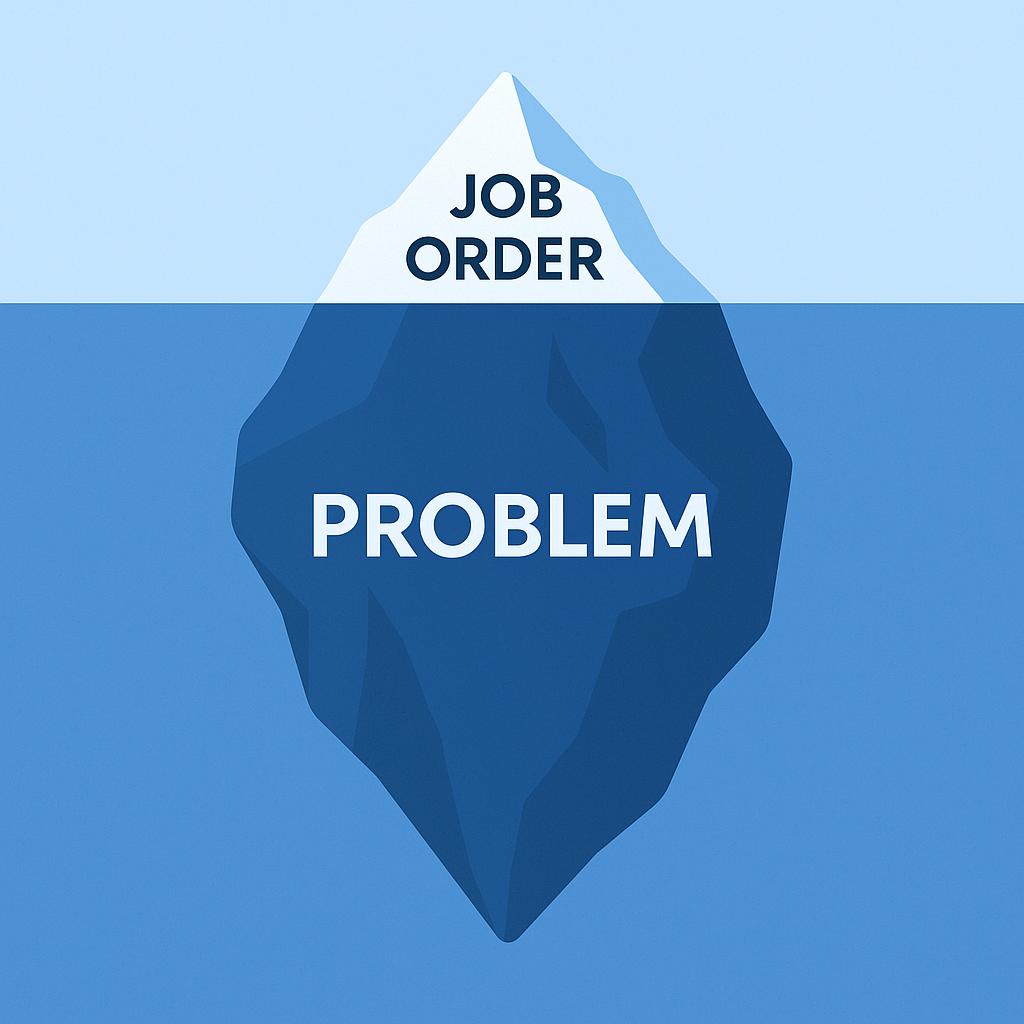Selling With Your Consultant
In my previous post, How to Prevent Unexpected Contract Terminations, I shared how systemizing consultant and client check-ins at key milestones...

Did you know that 78% of B2B buyers say salespeople lack the information they need to personalize conversations?
And a study from Forrester Research states that only 19% of the more than 400 US-based IT and Executive Buyers surveyed believe that their time spent with sales people (in a meeting) is valuable and lives up to their expectations.
Imagine the opportunities you'd unlock by actually understanding your buyer before your first outreach? Before your initial meeting?
As a sales professional selling IT professional services, you engage with a diverse range of buyers—CIOs, CTOs, VP Application Development, Director of Cloud Computing, Product Development Director, VP of Infrastructure, and more.
Each buyer type has unique priorities and challenges.
So, how do you ensure your message resonates with each buyer type?
For example, suppose on Tuesday afternoon you have an initial introductory meeting with Scott Hain, Director Cloud Computing at High Tech Software Inc. On Thursday morning you have a sales discovery meeting with Rick Pompa, Vice President, Infrastructure.
Do you take the same message, and the same questions to both meetings? Do you share the same ideas and insights with Rick as you do with Scott?
Do you share the same customer success stories with Rick as you do with Scott?
The answers to all of this lie in your understanding, and development of, buyer personas.
What is a Buyer Persona?
A buyer persona is a general, semi-fictional representation of your ideal customer based on data, market research, and real insights from your existing clients. A buyer persona is not a job title or a real person.
A buyer persona gives you insight into what your prospective customers are thinking and doing as they weigh their options to address a problem your company resolves. Much more than a one-dimensional LinkedIn profile, buyer personas reveal key insights about your customers’ including:
Buyer personas help sales professionals understand their buyers, enabling them to personalize messaging, taylor their questioning, address specific needs, and drive more productive sales conversations. Research consistently shows that buyers value interactions with salespeople who provide educational and meaningful insights.
When you understand how your prospects think—including their perceived barriers and risks in working with IT service firms, their challenges, goals, objectives, and the metrics by which they are measured—you gain the insights needed to align your positioning and messaging with their expectations.
While there are many components that make up a buyer persona, the key elements for sales professionals to understand include:
Master Role: The primary archetype, leadership or responsibility the buyer resides in within the organizational hierarchy (where they sit on the org. chart)
Responsibility: The specific duties, tasks, and areas of accountability that the persona is charged with in their professional role.
Goals: The primary objectives or desired outcomes your buyer persona aims to achieve
KPI’s: The key performance indicators used to measure the persona in their role (how they’re measured and evaluated)
Challenges: The pain points, obstacles, or frustrations that prevent the persona from achieving their goals.
Watering Holes: The places, platforms, or sources where the persona regularly goes to seek information, stay updated, network, and solve problems.
Think about your most coveted prospect. The one prospect you are dying to get a meeting with.
No imagine what life would be like if you knew the following about that prospect:
If you had that information do you think it might be a little easier to personalize your messaging?
How Buyer Personas Help Salespeople
At its core, buyer personas enable you to personalize and target your messaging for different audience segments. Instead of delivering the same sales pitch, email, or voicemail message and asking the same questions of all prospects, you can segment contacts by persona type and tailor your approach based on what you know about each. For example, if your ideal prospects include Director of Application Development and Manager of Cloud Computing, you would craft two very distinct approaches for each to create a valuable and memorable experience. Developing buyer personas allows you to effectively segment and personalize your outreach.
Additionally, buyer personas are crucial for sales call planning.
Your goal is to generate meaningful, productive sales conversations to build revenue pipeline.
With well-defined personas, you can confidently plan what to say, what questions to ask and which insights to share, ensuring your message is relevant to the buyer’s needs. This builds rapport, demonstrates credibility and establishes trust.
How Buyer Personas Drive Consultative Selling
The term consultative selling is often overused and has, unfortunately, become a cliché like "kleenex" for tissue. But what does it truly mean? At its core, consultative selling is about building a genuine partnership with the customer, focusing on their needs, challenges, and goals rather than simply pushing a product or service.
I define consultative selling in which the salesperson approaches every interaction with the sincere intention of helping the customer achieve their goals or solve their problems. It’s not about closing a deal but about adding value to the customer’s journey.
You can't do this without a deep undertsanding of your ideal buyer.
Asking Thought-Provoking Questions
When salespeople understand the customer's goals, the challenges they face and how they are measured (their KPI's), they can engage the customer with insightful and thought provoking questions that not only uncover their needs, but challenges and influences their thinking.
For example, instead of asking your customer "what is your biggest pain point?" you could say, "in our work with other cloud computing leaders, we're helping them meet security and compliance standards in their cloud environment. What are your top concerns regarding cloud security and compliance?
It's a smarter question, and it is far more inviting than just asking the customer "what is your biggest pain point?"
Educate with Insights and Fresh Perspectives
Enabled with buyer persona details, salespeople can position themselves as a trusted advisor by sharing relevant ideas, trends, and perspectives that the customer may not have considered. This may include challenging the customer’s current thinking or assumptions to help them arrive at the best solution.
Conclusion
Having a deep understanding of your buyers is no longer optional, or a luxury—it's the key to standing out in today’s competitive B2B sales landscape. Developing and leveraging buyer personas empowers you to craft personalized, meaningful interactions that resonate with your prospects’ unique challenges, goals, and priorities.
When you take the time to uncover what drives your buyers, how they measure success, and the obstacles they face, you equip yourself with the tools to ask smarter questions, deliver relevant insights, and create impactful conversations. This consultative approach builds trust, establishes credibility, and, ultimately, positions you as a valuable partner rather than just another salesperson.
Remember, personalization goes beyond addressing someone by name—it’s about addressing their needs, ambitions, and concerns. So, before your next meeting or outreach, ask yourself: How well do I truly know this buyer? What fresh perspectives can I offer that align with their world?
The salespeople who invest in understanding their buyers will unlock opportunities others miss. Start building your buyer personas today, and watch how they transform your approach—and your results.
To learn more about buyer personas and the buyers journey and the role they play in consultative selling, downloading our eBook, Your Guide to Mastering Consultative Selling.

In my previous post, How to Prevent Unexpected Contract Terminations, I shared how systemizing consultant and client check-ins at key milestones...

About a year ago, I was serving as the fractional revenue leader, managing sales and recruiting for a client.

If you’ve worked in staffing long enough, you’ve been trained to chase job orders.